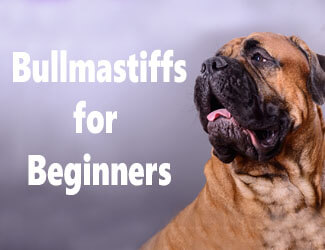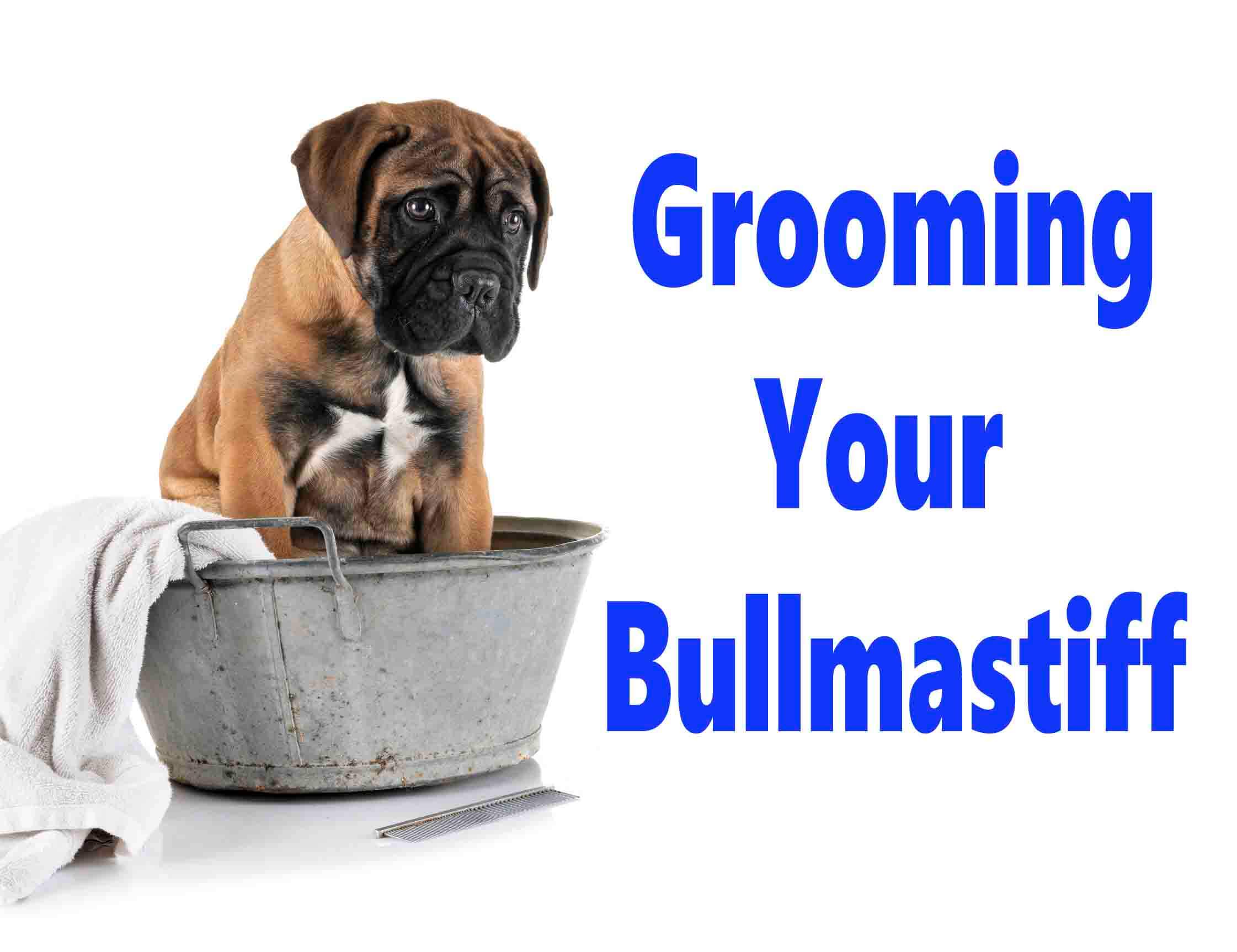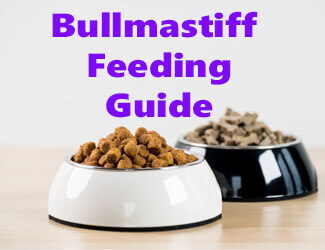Bullmastiff Dog Breed Information
History, Traits, Issues
by Ken Alden
The Bullmastiff dog breed can seem like big, lazy oafs. Their size, however, is no accident, and in addition
to accidentally knocking over small children with their girth, they
instinctually distrust and pounce on anyone they don’t recognize.
About The Bullmastiff Dog Breed...
Bullmastiffs were bred to protect large English estates from poachers. By combining the small but aggressive pit bull with the large but docile mastiff, the resulting bullmastiff is a large, amiable dog that loves lounging around home with its people, but is very protective and fearless when the family is threatened.
Pro-tip: Ever try lifting a Bullmastiff? Their weight can hurt not only your back but their joints when they hop down from cars, sofas or even your bed. To protect your back and theirs check out the best Mastiff ramps on Amazon.com now.
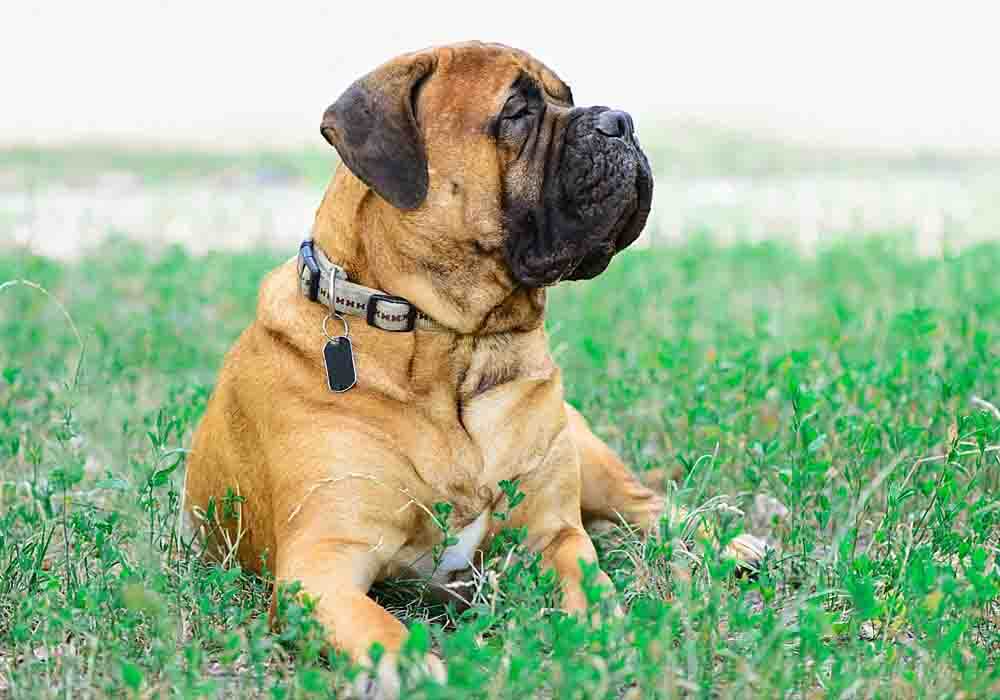
What Is The History Of The Bullmastiff?
During the mid to late 19th century, the English aristocracy held large country estates and game preserves. The large size of these tracts of land was hard to patrol, and poachers were a constant problem.
The nobility enforced harsh penalties for the crime so that poachers often faced the death penalty. Instead of curtailing the behavior, however, the severe penalties only made poachers more likely to shoot it out with the gamekeepers if they were caught. Instead of risking the lives of human guards, gamekeepers bred a new type of dog suited to protecting the estates.
Surely, they experimented with the combination of several breeds in various ratios. By combining the English bulldog with the English mastiff at a ratio of 40 to 60 percent, though, they created a dog that was perfectly suited to guard the property.
During the day, the mere sight of
the large, powerful dog was enough to discourage poachers. At night, the
bullmastiff dog breed's quiet demeanor and dark face gave it the ability to stalk
unwelcome visitors easily. The dogs would quietly stalk would-be poachers,
quickly sprint short distances to overtake and pounce on them, then use their
considerable mass (they would pin the intruders down but not bite or maul them)
to hold the poachers until the gamekeepers could come to apprehend them.
Modern History of the Bullmastiff Dog Breed
Gamekeepers, of course, began to
argue about who had the best guard dog protecting their estate, and would hold
competitions to dispute the issue. Around the same time, dog shows were gaining
popularity in England. By 1924, bullmastiffs were recognized as a uniquely
significant breed by the United Kennel Club (UKC). In 1933, they were
recognized by the American Kennel Club (AKC) as well.
Despite their origin as “the
Gamekeeper’s Night Dog,” bullmastiffs are now more suited as gentle giants that
prefer to spend most of their time lounging around the apartment but are capable
of fending off danger when provoked by strangers. Considerable amounts of
training and socialization are required in the first couple years of the dog’s
life to ensure that they err on the side of docile house dog versus vicious
guardian.
Bullmastiff Traits
Though they were bred as 60
percent English Mastiff and 40 percent English bulldog, in 1924, bullmastiffs
were recognized as a uniquely significant breed by the United Kennel Club
(UKC), and in 1933 they were recognized by the American Kennel Club (AKC) as well.
This established the bullmastiff as a unique breed, which was judged on 6
distinct categories.
Pro-tip: Bullmastiff anxiety, aggression, destructive chewing, jumping up, fearfulness, and other behaviors can be controlled with the right training program.
Here’s a great course that
addresses these issues along with many other dog training basics: Check it out now!
General Appearance
An ideal bullmastiff is powerfully built, yet active. Judges look for overall symmetry, as well as evidence of strength, endurance, and alertness.
Their Head...
The breed
standard for the head
includes several categories.
- Expression. A bullmastiff should have a keen and alert expression, and appear intelligent.
- Eyes. Its eyes should be dark and medium in size.
- Ears. The ears should “V” shaped and, though set high and wide on the head, should flop down and carry close to the cheeks, giving the skull a square appearance. The ears should be darker in color than the rest of the body and medium in size.
- Skull. The dog should have a large, broad head with well developed cheeks and a fair amount of wrinkles when it is alert. The forehead ought to be flat, and the stop moderate.
- Muzzle. The dog’s muzzle should be broad and deep, at a ratio of about 1 to 3 in comparison to the rest of its head. It’s preferable if the muzzle is dark and the flews are not too pendulous.
- Nose. A bullmastiff's nose should be dark with broad and large nostrils. It is very undesirable for a dog to have a lack of foreface and nostrils set high on top of the muzzle because it is a reversion back to bulldog features.
- Bite. The dog’s bite should be either level or slightly undershot. It should have large canine teeth set wide apart.
Their Body...
The standards of the bullmastiff breed’s body are also divided into several categories.
● Neck. Ideally, a
bullmastiff’s neck should be moderately long, slightly arched, and very
muscular. It should have the same circumference as the dog’s skull.
● Topline. Its topline
should be straight & level from the dog’s withers to its loins.
● Body. The dog
should have a compact body with a wide and deep chest. Its ribs should be well
sprung and well set down between the forelegs.
● Back. It’s back
should be short in to give the impression of a well balanced dog.
● Loin. Its loin
should have a fair amount of depth of flank. It should also be
wide muscular,
and slightly arched.
● Tail. A
bullmastiff dog breed's tail should be bet on high, be strong at the root,
and taper the hocks. While it is allowable to be either straight or curved, it must never
be carried in hound fashion.
Their Forequarters...
The breed standard for bullmastiff dog breeds forequarters are as follows:
● Shoulders. A
bullmastiff’s shoulders should be muscular, but not overloaded, and should be
slightly sloping.
● Forelegs. Its forelegs
should be well boned, straight, and set wide apart.
● Elbows. Its elbows
should be turned neither in nor out.
● Pasterns. The pasterns
should be straight, connecting the foreleg to medium sized feet with round,
well arched toes.
● Pads. A
bullmastiff’s pads should be thick and tough, and should have black
nails.
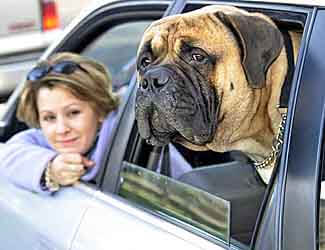
Coat
A bullmastiff dog breed's coat should be short and dense, which provides good weather protection. It can be colored red, fawn, brindle, or any combination thereof. A tuft of white on the chest is acceptable, as long as it is not too large.
Hindquarters
The dog’s hindquarters should be broad and muscular. A well defined second thigh denotes power, but if it is too developed, it becomes cumbersome. There should be moderate angulation at the hocks. Splay feet and cow hocks, on the other hand, are seen as serious defects.
Bullmastiff Dog Breed Issues...
All dog breeds have their issues and Bullmastiffs are no different. Here are some things you should consider if you’re thinking about bringing a Bullmastiff home.
Bullmastiffs are Large
The bullmastiff’s large size and
history as an estate guardian can cause several issues that you should take
into consideration when choosing a dog breed. Though they grow to be easy
going, low energy adults, they spend the first two years of their life as
highly energetic puppies that can have a mind of their own. It’s important to
start training and socialization early so the dog doesn’t establish habits that
will become problematic when it grows to full size.
Drool and Snoring
Bullmastiffs drool and snore. Owners often carry a hand towel with them at all times to clean up the slobber, and quickly grow accustomed to shimmering stains on their clothes and furniture.
Tricky Exercise Requirements
Though they don’t need much exercise to maintain their health as an adult, while they are still growing it is important that they are fed and exercise in appropriate amounts and intervals, so they develop their lean muscle tone at even rates.
Over exercising, for example, can lead to the over development of certain muscle groups compared to their counterparts, creating strain and damage to the joints as the surrounding bones grow.
You Need an Appropriate Yard
If letting a bullmastiff exercise itself in a backyard, it is important that it has access to shade and water in the summer and isn’t left out in the cold for too long in the winter. Bullmastiffs do not do well in either extreme, though they are particularly prone to heat exhaustion and heat stroke due to their short muzzle.
It’s also critical that the yard
is fenced because the bullmastiff’s instincts as an estate guardian could lead
to the dog expanding and protecting a territory beyond your yard. It is also
fiercely protective against strangers and likely to attack people or pets that
get too close. They do not live well with other animals, such as cats, and are
especially combative with dogs of the same sex.
Bullmastiff Common Health Issues
Bullmastiffs’ size also creates many potential health issues, and the expected lifespan is only 8 to 10 years. Some of the common ailments can be screened for, but most are not apparent until the dog is full grown. Bullmastiffs also have an unusually high tolerance for pain, so it can be difficult to notice if the dog is suffering.
Some of the most common health
problems bullmastiffs face are described below.
Bloat...
Also known as gastric dilation volvulus or gastric torsion, bloat is a life threatening condition that can be common among large, deep chested dogs like bullmastiffs. It occurs when the dog’s stomach is distended with gas or air and then twists. The gas is trapped in such a way that the dog cannot vomit or belch to release it. The normal return of blood to the heart is impeded, so the dog’s blood pressure drops and it goes into shock. If untreated, it can cause death.
Bloat is more common in older dogs and those that are fed one large meal per day, eat rapidly, drink excessive amounts of water after eating, and then allowed to exercise vigorously. Symptoms to watch for include a distended abdomen, excessive salivation, and retching without throwing up. The dog may also may be restless, depressed, lethargic, and weak but have a rapid heart rate.
There is some indication that the tendency toward this condition can be inherited, so dogs that experience it should not be bred.
Cancer...
Bullmastiffs can develop cancer,
which can often be treated both surgically and medically but removing tumors
and chemotherapy. The types of cancers most often developed by bullmastiffs are
lymphosarcoma, osteosarcoma, hemangiosarcoma, and mast cell tumors.
Hip Dysplasia...
Hip dysplasia is a heritable
condition in which the thigh bone doesn’t fit into the hip joint snuggly. Some
dogs show pain or lameness in the legs, though others do not show any symptoms
until they have aged, and the condition has been worsened by environmental
factors such as rapid growth from a high calorie diet or injuries from jumping
or falling.
Elbow Dysplasia...
A dog’s elbow is formed by 3 different bones, and if the bones grow at different rates, it can cause joint laxity and painful lameness. It may be corrected by surgery or the pain may be controlled by medication, but it is a hereditary condition common among large breeds (it affects 13.8 percent of bullmastiffs), and as such, dogs with the condition should not be bred.
Subaortic Stenosis...
This is a common heart condition in which the aorta narrows below the aortic valve, causing the heart to work harder to supply the body with blood. This can result in fainting or even sudden death. Dogs are typically diagnosed by a veterinary cardiologist after a heart murmur is observed. Though the mode of transmission is yet to be understood, it is known to be an inherited condition, so dogs with subaortic stenosis should not be bred. Bullmastiff dog breed
Cystinuria...
Dogs with this genetic disorder cannot reabsorb the amino acid cystine back into their kidney tubules, resulting in the formation of bladder or kidney stones, which can cause life threatening blockages of the urinary tract. This is especially common in males.
Panosteitis...
Panosteitis is a perplexing ailment in which young puppies suddenly experience full or partial lameness. This can be treated with pain medication and usually goes away on its own accord by the time the dog is fully grown. It is, however, often misdiagnosed as elbow dysplasia, hip dysplasia, patellar luxation, or even more serious disorders, which can lead to unnecessary invasive surgeries.
Skin Problems...
Bullmastiffs have sensitive skin.
They are prone to rashes, sores, and irritations, as well as contact or
inhalant allergies to detergents, chemicals, or airborne allergens such as
pollen, dust, and mildew. Soft, clean bedding in the dog’s crate will prevent
sores, and it’s important to check your dog’s skin often and treat skin
problems right away.
Pro-tip: Bullmastiff's (and their owners) love dog crates…and for good reasons. Crates keep dogs from mischief while you're away, are perfect for house training, for traveling by car, and provide the dog a place to de-stress. Check out the best Mastiff crates on Amazon.com now.
Care Of A Bullmastiff
Because Bullmastiff dog breeds are a unique and specific dog, they require a unique and specific care. Though they are overall easy going, they can be headstrong and requires a firm, consistent owner. They’re not typically recommended for first time dog owners.
Nutrition...
Bullmastiff breeders often recommend either adult dog food or large breed puppy food for puppies. It’s important that bullmastiff puppies are kept lean as they grow to avoid taxing their quickly growing bodies. As discussed above, bullmastiffs are prone to several types of joint problems if they are overweight or develop muscle unevenly.
Also discussed above, the risk of bloat means that it is a good idea to feed bullmastiffs two meals (3 1/8 to 4 1/8 cups of a high-quality dog food) per day to avoid one giant feeding that can distend the gut.
For growing puppies, it may even be a good idea to distribute the food over more than 2 meals because they are naturally more active. Exercise immediately before or after eating should be discouraged to prevent stomach torsion.
Different bullmastiffs will require different amounts of food, depending on their genetics and activity level. When looking at the dog, you should be able to see a waist. Another way to check for obesity is to place your hands on their back, with your thumbs along the spine, and the fingers spread downward. From this position, you should be able to feel but not see their ribs without pressing too hard. If you can't feel their ribs, they need less food and more exercise.
Grooming...
Their short coat makes grooming the bullmastiff dog breed very easy. Though some seasonal shedding is to be expected, it’s easily managed with frequent grooming, and the dogs only need to be bathed as needed if they get into something filthy. A balanced diet and good nutrition contribute to a healthy coat. Be watchful for the coat and skin becoming too oily and signs of the skin conditions discussed above.
Exercise...
While they are known to be more sedentary than most other breeds, bullmastiffs need daily brisk walks or time and time in the yard to maintain their muscle tone. The key word there is walk. Bullmastiffs do not make a good running partner.
When raising a puppy bullmastiff,
care must be taken not to over exercise the dog because their body is growing
rapidly, and this can lead to future joint problems.
Learn more about Mastiff exercise requirements...
Training...
The most critical aspect of training a bullmastiff is that training and socialization begin early. The breed can be rather strong willed, and it's easier to train a small puppy not to lay on the couch than it is to move a 120 pound adult dog that has grown accustomed to getting its way. Bullmastiff dog breed
Socialization must also start immediately. Because of their origins as an estate guardian, bullmastiffs are inherently distrustful of strangers. The more often (and sooner) the puppy is exposed to people and sees you interact with them as a friend instead of as a foe, the less likely it will be to be hostile to any new person you pass on the street. People often enroll in their bullmastiffs in puppy socialization classes, so they have a lot of interactions with other dogs and people in a controlled environment. In lieu of that, you can also take the puppy to dog parks or invite your friends over to meet the dog.
When it comes to the Bullmastiff dog breed it’s best to train them with firmness, fairness, and consistency. They quickly grow bored with repetitive training methods, which could lead to them acting out. Instead, positive reinforcement techniques should be used, never physical punishment, which could cause the dog to lash out.
Living With A Bullmastiff
Their docile nature and tendency to not bark makes bullmastiffs ideal for apartment living, as long as you can handle the drooling and snoring and take it out for a daily brisk walk or two. Because they are natural guardians, they’re perfectly comfortable being alone for many hours while its family is at school or work, as long as they get plenty of interaction when you’re home. They don’t do well banished to a fenced backyard or kennel run because they prefer to be with the group, which is exactly where a guard dog is most effective, anyway.
Bullmastiffs are generally good around well behaved children, though their size can result in accidentally knocking over little ones. As with all dog breeds, children should never be left unsupervised with a dog and should be taught how to handle them properly to avoid provoking the dog. They are naturally distrustful of strangers, and their size is a significant deterrent.
The Bullmastiff dog breed is not particularly well suited for households with multiple animals. With early socialization, however, they can be trained to live with the family cat. If you plan to have 2 bullmastiffs, its best to have dogs of opposite genders (spayed and neutered) because they are noticeably more aggressive to dogs of the same sex.
The Bullmastiff dog breed may look intimidating, but with consistent training, early socialization, and a moderate amount of exercise, they can be a great addition to your family. They’re lovable giants that love to cuddle, but when provoked will not hesitate to defend you and your loved ones.

About the Author...
Ken Alden, a dedicated Mastiff owner for over eight years, is acclaimed for his expertise in care, grooming, and training. Read more About Me and my dog Shadow.
- Mastiff Guide Home ›
- Bullmastiffs ›
- Bullmastiff Dog Breed Info




